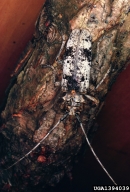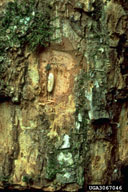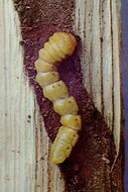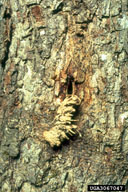White oak borer
Goes tigrinus (De Geer) (Coleoptera: Cerambycidae)
Orientation to pest
White oak borer, Goes tigrinus (De Geer), is native to North America and is found in much of the eastern United States in association with white (Quercus alba L.) and overcup (Quercus lyrata Walter) oaks. Damage is greatest to younger trees and losses from this species are important in oak stands grown for veneer or cooperage (barrels). Reproduction is often concentrated in selected trees (brood trees) and removing brood trees can help control the pest at the stand level. Adult beetles emerge in May and June. Eggs are deposited in niches 6 mm in diameter that are cut singly into the bark. As the larvae tunnel directly into the wood, sap often oozes from the entrance holes in the tree and fine moist frass is pushed out of the tunnels to the outside. Larval galleries are about 12 mm in diameter and 15 cm long. Pupation occurs within the gallery. One generation takes about 3 to 5 years.
Hosts commonly attacked
White oak borer breeds in white (Q. alba) and overcup (Q. lyrata) oaks.
Distribution
White oak borer is found in the eastern United States from New York to Florida and west to Michigan and Louisiana.
Images of white oak borer
| Figure 1. Adult white oak borer, Goes tigrinus | Figure 2. Egg of white oak borer, exposed by removal of bark flap |
| Figure 3. Larva of white oak borer | Figure 4. Signs of of white oak borer activity: (left) frass pushed out of borer hole in tree trunk; (right) emergence holes in tree trunk |
Important biological control agents related to this pest species
Natural enemies of white oak borer have not been studied.
Articles
- Donley, D. E. 1978. Distribution of the white oak borer Goes tigrinus Degeer (Coleoptera: Cerambycidae) in a mixed oak stand, pp. 529-539. In: Pope, P. E. (ed.). Central hardwood forest Conference II. Proceedings of a meeting held at Purdue University at West Lafayette, Indiana, November 14-16, 1978 West Lafayette, Indiana, USA. Department of Forestry and Natural Resources, Purdue University.
- Solomon, J. D. and D. E. Donley. 1983. Bionomics and control of the white oak borer. Research Paper SO-198, Southern Forest Experiment Station, USDA Forest Service.








